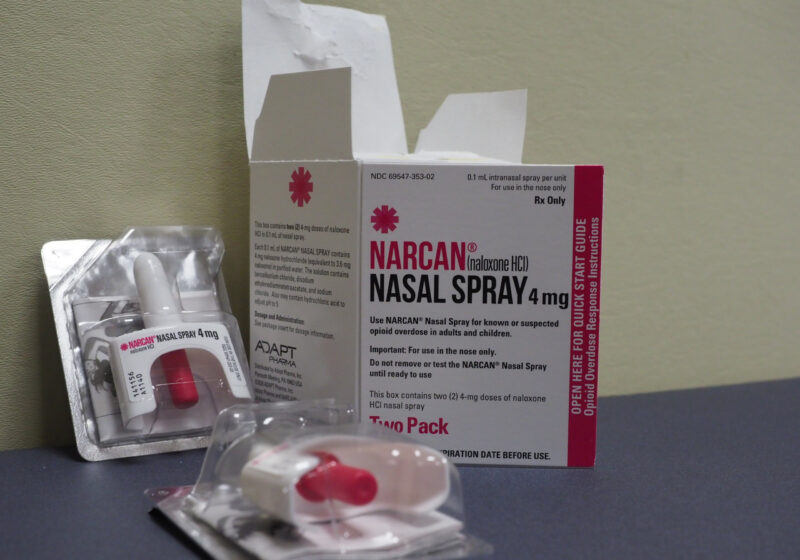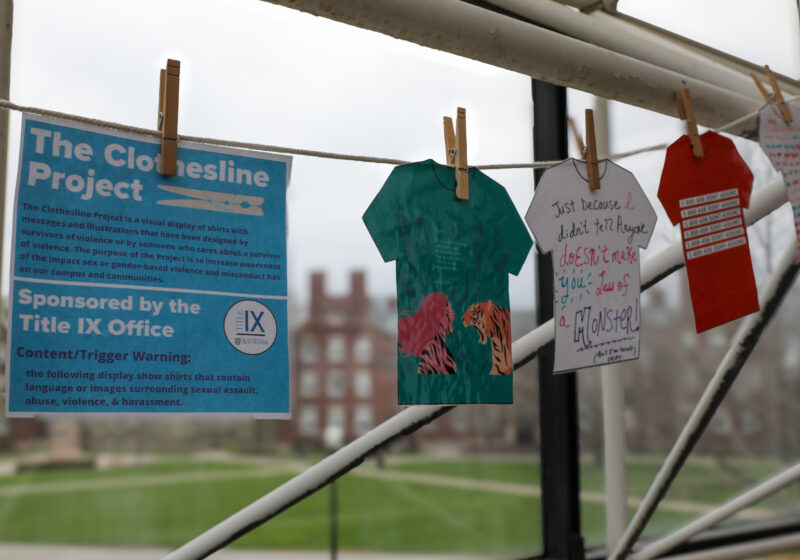Abigail Walker and Reed Wojick, two Credentialed Recovery Peer Advocates from Strong Recovery, came to Wilson Commons on Tuesday to educate the University community on treatment for opioid overdoses.
Narcan, also known as Naloxone, is a nasally administered medicine that temporarily reverses the effects of an opioid overdose. Each dose of Naloxone contains 2 milligrams of medicine and lasts for 30 to 90 minutes. According to Walker and Wojick, it is a life-saving treatment that has greatly decreased the number of deaths related to opioid overdoses.
“Preventing opioid overdose occurs right as the person’s at high risk,” Wojick said. “Family members and others should learn how to prevent an opioid overdose, so that’s why you all are here today.”
Someone who is in an opioid overdose will be completely unresponsive to being shaken or called, Walker and Wojick said. They may look like they are sleeping; however their fingernails will often start to turn blue or purple and their breathing will be labored. In some cases they may stop breathing. Walker and Wojick emphasized that it is always important to call 911 when someone has overdosed but especially critical when the overdosed person has stopped breathing.
According to Walker and Wojick, after calling 911 it is best to complete a technique called the “sternal rub” to a person who is unresponsive because of an overdose. To complete the sternal rub, vigorously grind your first into the center of the unresponsive person’s chest for 10 seconds. If the person is still unresponsive after completing the sternal rub, it is time to administer Narcan.
To administer a dose of Narcan, lay the person on their back and tilt their head backwards. Grasp the spray firmly and insert it into one of the person’s nostrils. Walker and Wojick said that the administrator of Narcan will know that the spray is far enough in when their fingers touch the unresponsive person’s nose. Administer the entire spray, and do not do a test spray beforehand. If after two to three minutes the person is still unresponsive, administer a second dose in the other nostril.
Walker warned that it would not be pleasant when the overdosed person wakes up after being Narcaned.
“When you wake up from an overdose, you’re not like, ‘Oh, thank God, you just saved my life,’ it’s more of a panic mode, like ‘what are you doing? why did you do that?’” she said. “It’s a very scary feeling coming out of an overdose, and as someone who has given Narcan, persons can and often are very upset.”
Walker and Wojick said that this is because Narcan undoes the effects of opioids, essentially putting the overdosed person into a state of withdrawal for the duration of the medicine. Although the medicine may last for up to 90 minutes, it is possible that the effects of the opioids last longer than the effects of the Narcan, and thus it is possible for someone who has been Narcanned to fall back into an overdose after the Narcan wears off. They said that it is important that the administrator of the Narcan stays with the overdosed person until emergency medical help arrives.
Walker and Wojick acknowledged that some people may be scared to call for emergency medical help and stay with the overdosed person due to fear of legal repercussions. Still, they said that New York State has implemented multiple protective measures for people giving medical aid for opioid overdoses.
Under NYS law, no one who gives life-saving aid to someone who has overdosed can be accused of unlawful practice.
The Good Samaritan Law gives additional protection to anyone who administers Narcan, although it does not protect other people present at the scene, according to Walker and Wojick.
Narcan is available without a prescription at most major pharmacies in Rochester, as well as large stores such as Walmart and Wegmans. Individuals with insurance can utilize the Naloxone Co-Payment Assistance Program (N-CAP) to have a co-payment of $20-40 when purchasing Narcan at a pharmacy. Narcan is also available at organizations such as Trillium Health, Recovery All Ways (R.A.W.), and the New York Recovery Alliance.
Narcan kits are available in emergency health boxes around the city. Their closest locations to the River Campus are the Nielsen House at 30 Millbank Street and the Dollar Tree at 797 Elmwood Avenue. The kits closest to the Eastman Campus are the Charlotte Square on the Loop at 120 Charlotte Street and the DMV at 200 E Main Street. A map of all emergency kit locations can be found on Monroe County’s website.
Strong Recovery provides Narcan training sessions each month, one on the secondTuesday of the month at 1 p.m., another on the secondWednesday of the month at 5 p.m., and another on the last Thursday of the month at 1 p.m. You can register for the free training sessions by registering online, emailing Teresa Fox at Teresa_Fox@urmc.rochester.edu, or calling Strong Recovery at (585) 275-1829 for the Tuesday/Thursday sessions or at (585) 275-4492 for the Wednesday sessions. All attendees will receive a free Narcan kit with two doses of Naloxone.



